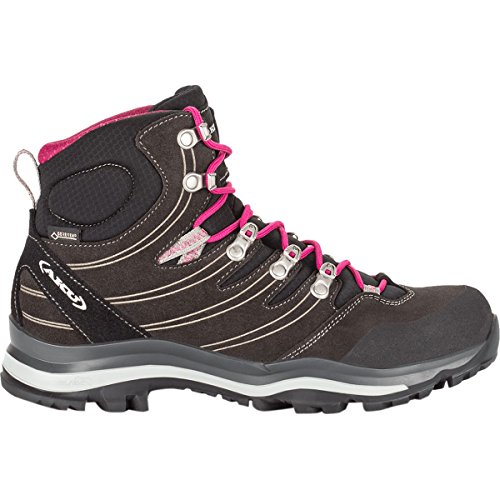Best Women’s Hiking Boots (Reviews) for Inca trail
Making to the top 5 hikes globally, the Inca Trail is the most popular hike in South America. The classic trail takes four days and three nights to complete, and you will hike muddy surfaces and gravel in the rainy season and meet areas of half mountain while enjoying the views of archeological Inca ruins.
The Inca trail is challenging, and most hikers will go with hiking boots (mid-cut and high cut) and not trekking shoes. Ankle support, fantastic grip, and traction and challenging build are some of the features you need in your hiking boots, especially if you’re also backpacking.
Top Women’s Hiking Boots for Inca trail
1. MILLET Women’s High Rise
Hikers, who are determined to make the hiking as fun as possible, can take a leap of faith with the brightly colored MILLET Women’s High Rise.

See reviews and pricing on Amazon
Even if the colorful appearance strikes first, the boots are more than meets the eye. The footwear has a mid-cut design, and it’s made with a nubuck upper and Millet Gore-Tex membrane. The leather looks nice and resists to tear and wear, whereas the Gore-Tex will keep your feet dry, no matter where water is coming from. The neoprene gaiters block out the elements, and the outsole is stiff for more durability but doesn’t affect flexibility.
Stability while hiking isn’t an issue due to the well-cushioned heel stabilizer, the dual-density EVA midsole, and the Vibram outsole. The boots present a hybrid lacing style, have padding in the right places, and ensure adequate grip on muddy and rocky trails. You may need a couple of days to break them in, but they’re worth the effort.
2. AKU Ultra Light Micro GTX w’s, Women’s Hiking Shoes
For women hikers interested in rugged footwear with trekking abilities, the AKU Ultra Light Micro GTX w’s, Women’s Hiking Shoes (Alterra), are a great choice. The boots are made for medium difficulty tracks and longer tracks like the Inca trail. The shoes’ upper body is made with elastic material for the collar and tongue, for best comfort and fit.

See reviews and pricing on Amazon
The boots have an asymmetric build for the outsole with the proprietary AKU Elica technology, which provides the superior distribution of the load over the plantar area. It will also improve foot roll, for safer trekking. The boots are made for the female plantar anatomy. The shoes come with the Gore-Tex membrane for waterproof and breathable wear, metal hardware, contoured heel, and rubberized toe cap.
The boots run a tad small, so double-check the sizing before placing your order. They are rough and dependable for the Inca trail but have feminine and catchy details too.
3. Hanwag Women’s Tatra Light Lady GTX
Hanwag Women’s Tatra Light Lady GTX may not draw attention on shelves, but they will impress you on the Inca trail, which is far more critical.

See reviews and pricing on Amazon
The boots are made with nylon and suede, so they’re comfortable right out of the box. They look rough and rigid, but don’t need a break-in and are lighter than you’d expect. The Gore-Tex membrane ensures dry wear, whereas the ergonomic cuff build and padding will ease your efforts. The unique tread of the sole is made with 3D PrismBase technology, resulting in a lightweight design.
The lower height provides stability, whereas the padding improves comfort. The 2-zone lacing allows a better fit for the boots, and the click clamp eyelets ease out the use. The tongue goes higher in the front for better support for the ankle, and the toe cap is reinforced for protection against the stone bruising. The sole is rigid and reliable, and the grip is aggressive on most surfaces.
The looks could be more feminine, but the boots remain an excellent spend for the Inca trail on any given moment.
What’s the best way to select the boots for the Inca trail?
Many aspects are affecting your final decision, so keep reading to find out what you should pay attention to when selecting your footwear for the Inca trail.
The type of footwear
Hiking boots, trekking boots, and even trail runners may be used when taking the Inca trail. However, hiking boots make the safest choice as they provide the best ankle support. The Inca trail has many uneven tracks, and if you’re also heavily backpacking, you will need boots to take that load.
Waterproofness &breathability
The weather in the Andes is full of surprises, and you don’t know when it’s sunny or when it’s raining again. Not only that, your boots should be comfortable enough to accommodate warm and thermal socks, but they should also be waterproof.
You don’t want the water to get inside the boots, but you don’t want to hike in sweaty feet either. That’s why your hiking boots should also be breathable, so that moisture is helped to escape. Gore-Tex is the most common technology with waterproof and breathable abilities, but other brands use proprietary technology (Keen).
Rugged build
Even if you’re not backpacking the entire Inca Trail, you still need boots that are tough and ready to take a beat. Several features and materials will make the shoes more dependable for the Inca trail.
Hiking boots with a durability feel, metal hardware, reinforced toe cap and heel, and rigid sole will increase the chance of completing the Inca trail without breaking by the end of it.
The materials should be resistant to abrasion, roots, and rocks, wear and tear. It would help if you stayed away from the thinner materials in the upper body. Even if they’re breathable and comfortable, they pose a high risk of tearing throughout your hike in the Andes.
Stability, grip, and traction
As the trails can get slippery and muddy, grip and traction are essential. Look for rigid soles (Vibram is the most effective) that come with deep and patterned lugs for better grip and traction. Self-cleaning lugs are also great as they are clean as you go so you don’t lose any grip or traction.
Some boots come with mudguard, which keeps the muddy elements away from the shoes.
Molded EVA midsole, stability shank, and smart design will also provide stability inside the boots, reducing the risk of injuries.
Side note
No matter your final decision, make sure that you always break-in the boots before you head to the Inca trail. Your shoes may fit great when out of the box, but they can become uncomfortable while you’re on some muddy trails.
FAQs
Q: Do you always have to have waterproof boots on the Inca Trail?
A: There are two main seasons when you can take the Inca trail: the winter season (dry) and the summer season (wet season). Even if you’re planning for a winter hike on the Inca trail (colder temperatures and such), you should still have waterproof boots. The weather is unpredictable, and you don’t want to have any surprises.
Q: Mid-cut or high-cut boots?
A: Most recommend mid-cut boots, as they provide excellent ankle support, without adding too much weight. Even if high-cut boots can work, they are heavier than mid-cut models. You will be trekking for hours, mostly backpacking, and you will consume more energy if the shoes are heavyweight.
Q: Are hiking boots mandatory on the Inca trail?
A: Trekking shoes also make a safe choice for the Inca trail, but they will not provide the ankle support you need for such a long experience. Should you be determined to use your favorite trekking shoes, you may pack them too.
At the end of the day, you will feel the need to give your feet a break, so a pair of light trekking shoes and even sandals will be great as long as you’re also wearing some warm socks.
Q: What’s the best material for hiking boots for the Inca trail?
A: Full-grain leather is the most durable and rigid material used on hiking boots. It’s naturally waterproof, and handles rocks, wear and tear very well. However, it’s heavier than synthetic materials and suede or nubuck leather. It would help if you also broke in full-grain leather boots, as it softens with each wear. Keep in mind that full-grain leather boots are more expensive than most boots.
Some hiking boots are made with suede and tear-resistant nylon, and they’re lighter than the full-grain leather boots. They can also work for the Inca trail, so it’s still a matter of personal choice at the end of the day.


